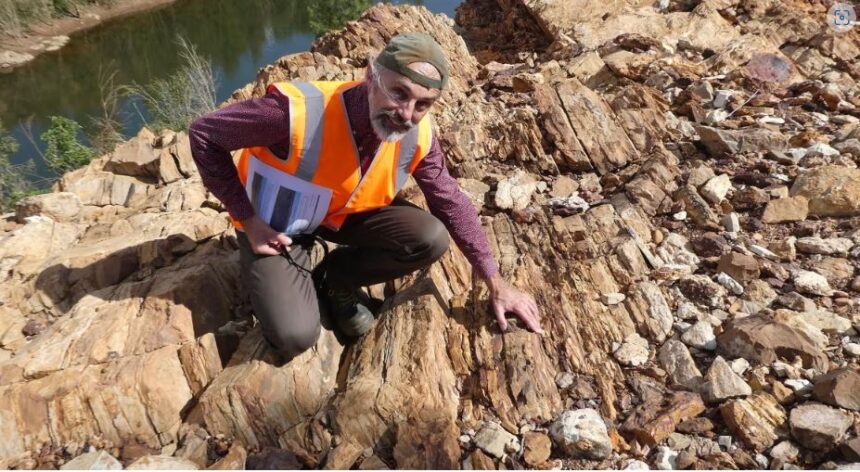| Pairing cutting-edge chemistry with artificial intelligence, a multidisciplinary team of scientists today published fresh chemical evidence of Earth’s earliest life concealed in 3.3-billion-year-old rocks and molecular evidence that oxygen-producing photosynthesis was occurring over 800 million years earlier than previously documented. |
| In a groundbreaking study published in the Proceedings of the National Academy of Sciences, scientists from the Carnegie Institution for Science and several partner universities and institutions analyzed over 400 samples, including ancient sediments, fossils, modern plants and animals, and even meteorites, to see if life’s signature still exists in rocks long after the original biomolecules are gone. Using high-tech chemical analysis to break down both organic and inorganic materials, Michael L. Wong, Anirudh Prabhu, and colleagues trained AI to recognize chemical ‘fingerprints’ left behind by life – signals that can still be detected even after billions of years of geological wear and tear. The results prove the possibility of distinguishing materials of biological origin (like microbes, plants and animals) from materials of non-living origin (like meteoritic or synthetic carbon) with over 90% accuracy. Impressively, these methods teased out chemical patterns unique to biology in rocks as old as 3.3 billion years. Previously, no such traces had been found in rocks older than about 1.7 billion years. The results, therefore, roughly double the window of time in which organic molecules preserved in rocks can reveal useful information about the physiology and evolutionary relationships of their original organisms. The work also provides molecular evidence that oxygen-producing photosynthesis (the process used by plants, algae and many microorganisms to harness sunlight) was at work at least 2.5 billion years ago. This finding extends the chemical record of photosynthesis preserved in carbon molecules by over 800 million years. Besides helping find evidence of Earth’s earliest life, this work advances a potential way to identify traces of life beyond our planet. Life’s evidence in ancient cells battered to near obliteration Earth’s earliest life left behind little in the way of molecular traces. The few fragile remnants such as ancient cells and microbial mats were buried, crushed, heated, and fractured within Earth’s restless crust before being thrust back to the surface. These transformations all but obliterated biosignatures holding vital clues to the origins and early evolution of life. Paleobiologists who search for signs of Earth’s most ancient life have long relied mainly on fossil organisms, including microscopic fossils of single cells and filaments, and the mineralized remains of cellular structures such as microbial mats and mound-like stromatolites, which provide convincing evidence of life as far back as 3.5 billion years ago. However, such remains are few and far between. A second line of evidence relies on the preservation of diagnostic biomolecules in ancient rocks. Life’s hardiest organic molecules – those derived from cell membranes or some metabolic processes – have been found in sediments as old as 1.7 billion years, while much older carbon-rich rocks preserve isotopic signatures that hint at a vibrant biosphere 3.5 billion years ago. However, most ancient rocks preserve neither fossil cells nor any surviving biomolecules. The vast majority of ancient carbon-bearing sediments have been heated and altered in ways that break every diagnostic biomolecule into countless small fragments. Those fragments have proven too small and too generic to provide any clues about ancient life – until now. The new work is based on the hypothesis that life’s molecules are rigorously selected for their biological functions (in keeping with a new law of nature proposed in 2023). Unlike the random distribution of molecules found in carbon-rich meteorites and other abiotic organic mixtures, life makes a few kinds of molecules in high abundance. Each chemical in a living cell has its own function. The new work suggests that the distribution of biomolecular fragments found in old rocks still preserves diagnostic information about the biosphere, even if no original biomolecules remain. Indeed, this new research shows that life left behind more than anyone ever realized — faint chemical “whispers” locked deep inside ancient rocks. The 406 measured samples came from seven major groups: Modern animals: vertebrates (e.g. fish) and invertebrates (e.g. insects).Modern plants: including both their photosynthetic parts (e.g. leaves) and non-photosynthetic parts (e.g. roots and sap).Fungi: including mushrooms and yeast.Fossil materials: e.g. coal, ancient wood, and shale rich in preserved algae.Meteorites: carbon-rich space rocks that could resemble prebiotic material.Synthetic organic materials: made in labs to simulate early-Earth chemistry.Ancient sediments: ranging from hundreds of millions to over 3 billion years old, with uncertain origins. The team used pyrolysis–gas chromatography–mass spectrometry (Py-GC-MS) to release trapped chemical fragments from each sample. They then used a specific type of machine learning model called “random forest,” which builds hundreds of decision trees to classify data and to extract latent ecological and taxonomic patterns. This is the first study to combine Py-GC-MS data with supervised machine learning to identify biosignatures in multi-billion-year-old rocks. Says team member Dr. Robert Hazen, Senior Staff Scientist at the Carnegie Institution for Science: “Think of it like showing thousands of jigsaw puzzle pieces to a computer and asking whether the original scene was a flower or a meteorite.” “Rather than focus on individual molecules, we looked for chemical patterns, and those patterns could be true elsewhere in the universe,” Dr. Hazen added. “Our results show that ancient life leaves behind more than fossils; it leaves chemical ‘echoes.’ Using machine learning, we can now reliably interpret these echoes for the first time.” The paper concludes: “Information-rich attributes of ancient organic matter, even though highly degraded and with few if any surviving biomolecules, have much to reveal about the nature and evolution of life.” A pioneering model The model’s performance was tested in three main ways: 1. Modern living animals and plants vs non-life samplesCould the model distinguish life-based organic matter from non-living origins (like meteorites or synthetic chemistry)?Yes, with up to 98% accuracy on known samples. When applied to ancient rock samples, the model found strong evidence for life in multiple 3.3-billion-year-old formations. 2. Photosynthetic vs Non-photosyntheticCould the model detect signs that an organism once used sunlight for energy?Yes, with 93% accuracy.The method identified photosynthetic signatures in rocks as old as 2.52 billion years. 3. Plant vs AnimalCould it distinguish plant-based life from animal-based life?Yes again, with 95% correct classification in modern samples.This type of classification is harder in ancient rocks due to the scarcity of animal fossils in the model’s training set. This is a point of improvement for future work. Seeing through the fog of time One key insight was that age makes detection harder. Younger samples from the last 500 million years retained strong biotic signals. For rocks 500 million to 2.5 billion years old, about two-thirds still showed life signatures. But in rocks older than 2.5 billion years, just 47% retained detectable evidence of life. For each sample, the model didn’t just report “life” or “non-life,” it gave a probability score. If a sample scored above 60% for “biotic,” it was considered a strong hit. This probability-based approach allows for nuance. For example, a coal sample that had been heated to over 400°C might have lost most of its biological markers and landed in the “uncertain” range. But well-preserved ancient samples—especially those that hadn’t been exposed to intense heat or pressure—still scored confidently in the “biotic” zone. The authors were also careful not to claim a sample was biotic unless it truly stood apart from abiotic materials, reducing the risk of false positives.Among the ancient samples that stood out as clear positives:Biotic material in 3.33-billion-year-old sediments from e.g. South Africa’s Josefsdal ChertPhotosynthetic life in 2.52-billion-year-old rocks from e.g. South Africa’s Gamohaan Formation. Why this matters for science, and space exploration The results suggest that machine learning applied to degraded organic matter can help resolve long-standing debates about the evolution of life on Earth in deep time. This method could also assist in the search for signs of extraterrestrial life. If AI can detect biotic “fingerprints” on Earth that survived billions of years, the same technique might work on Martian rocks or even samples from Jupiter’s icy moon Europa. The authors are careful not to overstate their conclusions. They acknowledge:The need for larger, more balanced sample sets, especially more fossil animals and diverse abiotic materialsSome samples still fall into a gray zone, with mid-range probability scores that don’t allow firm conclusions.The method is complementary, not a replacement, for traditional techniques like isotope analysis or fossil morphology. The team plans to refine their models, explore different types of machine learning, and test their approach on rocks from Earth’s Mars-like deserts. “This study represents a major leap forward in our ability to decode Earth’s oldest biological signatures,” says Dr. Hazen. “By pairing powerful chemical analysis with machine learning, we have a way to read molecular ‘ghosts’ left behind by early life that still whisper their secrets after billions of years. Earth’s oldest rocks have stories to tell and we’re just beginning to hear them.” Adds Dr. Wong: “Understanding when photosynthesis emerged helps explain how Earth’s atmosphere became oxygen-rich, a key milestone that allowed complex life, including humans, to evolve.” “This represents an inspiring example of how modern technology can shine a light on the planet’s most ancient stories and could reshape how we search for ancient life on Earth and other worlds. In future, we plan to test materials like anoxygenic photosynthetic bacteria — possible analogs for extraterrestrial organisms. This is a powerful new tool for astrobiology.” Says co-first author Dr. Anirudh Prabhu of Carnegie Science: “These samples and the spectral signatures they produce have been studied for decades, but AI offers a powerful new lens that allows us to extract critical information and better understand their nature. Even when degradation makes it difficult to spot signs of life, our machine learning models can still detect the subtle traces left behind by ancient biological processes.” “What’s exciting is that this approach doesn’t rely on finding recognizable fossils or intact biomolecules. AI didn’t just help us analyze data faster, it allowed us to make sense of messy, degraded chemical data. It opens the door to exploring ancient and alien environments with a fresh lens, guided by patterns we might not even know to look for ourselves.” |




